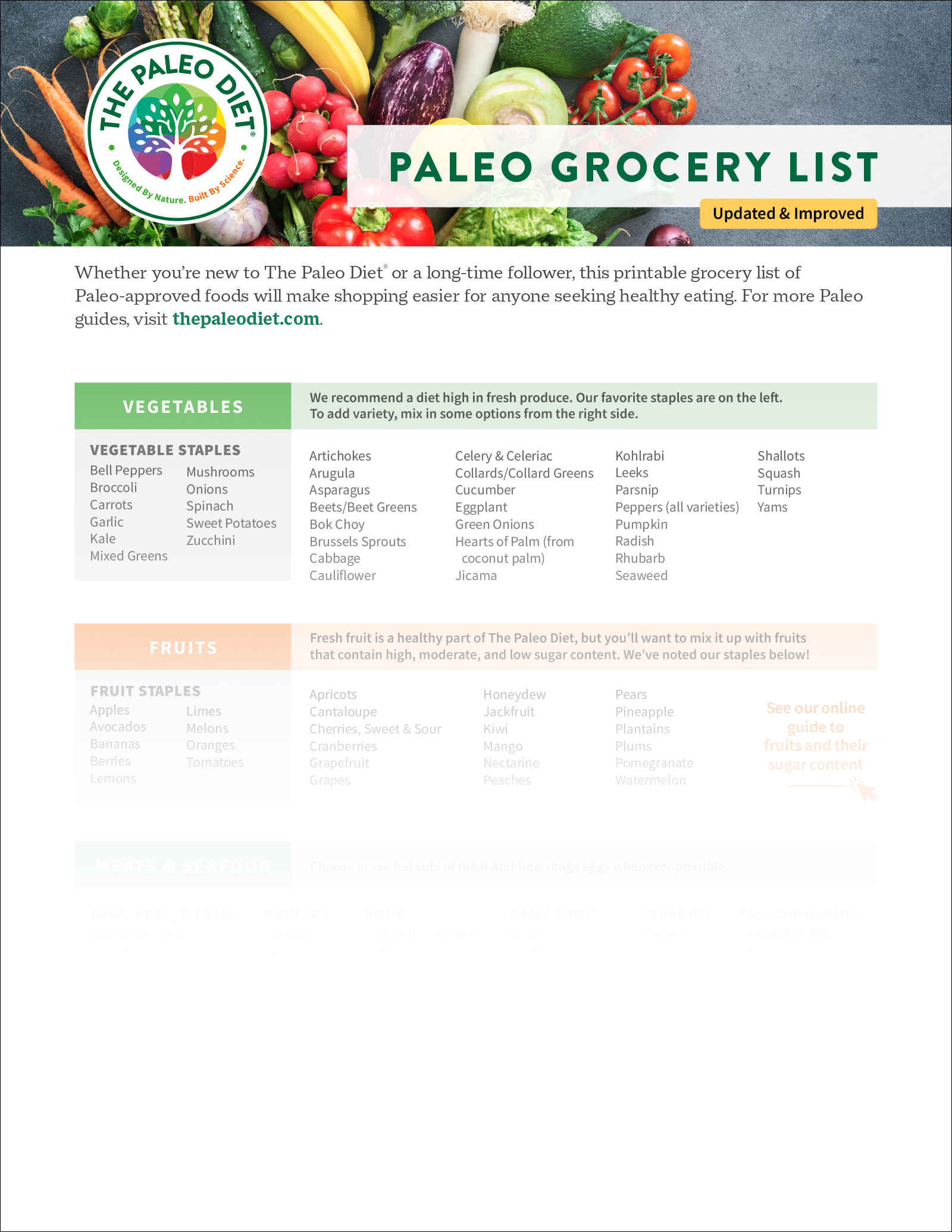Applying Paleo Principles to Therapeutic Diets in Patients with Digestive Conditions

The preservatives, dyes, additives, sweeteners, hormones, antibiotics, and artificial flavors present in modern food are new when we consider our nutritional history. Many of these elements are detrimental to our health and can exacerbate digestive conditions.
The Paleo Diet® is grounded in evolutionary biology, prioritizing whole, nutrient-dense foods while eliminating processed and modern agricultural foods. These exclusions align with many therapeutic diets designed to address digestive conditions, minimizing exposure to antinutrients (lectins and phytic acid), preservatives, and pro-inflammatory compounds. This helps eliminate inflammatory triggers, rebalance the gut microbiome, and improve gut mucosal integrity.
Managing digestive conditions is just one of the potential benefits of following The Paleo Diet. Patients may also improve their nutritional status, maintain sustained energy throughout the day, shift cholesterol balance toward high-density lipoprotein, reduce cravings, rebalance the acid-base ratio, and even experience weight loss, since non-processed foods tend to be less calorie-dense.
Therapeutic Diets and Paleo Modifications
There are many dietary protocols available for digestive conditions that aim to reduce symptom severity and achieve functional remission. Each diet is suited for improving key therapeutic targets that exist in different digestive conditions.
Many of these diets can become compatible with The Paleo Diet with just a few tweaks, so you can improve your patients’ gastrointestinal symptoms while concurrently reaping the benefits of The Paleo Diet.
The Low-FODMAP Diet
The Low-FODMAP Diet is the most often recommended dietary protocol for digestive disturbances, offering relief to 73% of participants with autoimmune gastrointestinal disorders.1 It postulates that fermentable oligo-, di-, and monosaccharides, as well as polyol carbohydrates (FODMAP), contribute to dysbiosis that gives rise to bloating, diarrhea, and abdominal pain.
For this therapeutic diet, patients should avoid high-fructose fruits and vegetables, lactose-containing dairy products, high-fructan grains, high-galactose legumes, and sugar alcohol–based sweeteners.2 To make the Low-FODMAP Diet Paleo, all grains, legumes, dairy, refined sugars, and processed foods must be removed, regardless of FODMAP content.
The Autoimmune Protocol Diet
The Autoimmune Protocol excludes the same foods as The Paleo Diet but with added restrictions on nightshade vegetables, nuts, seeds, and eggs. It is typically used to identify specific sensitivities with a strict elimination phase where all potential inflammatory foods are avoided, followed by a structured reintroduction phase. During reintroduction, foods are gradually added back one at a time to pinpoint which ones may trigger flare-ups or worsen symptoms.1
Trying an Autoimmune Protocol on The Paleo Diet means many inflammatory foods are already eliminated, but some Paleo foods are restricted and later reintroduced.
The Mediterranean Diet
The Mediterranean Diet emphasizes whole, minimally processed foods, similar to The Paleo Diet. This includes vegetables, fruits, whole grains, legumes, nuts, seeds, lean proteins, healthy fats, and some dairy. The high fiber, omega-3, and antioxidant content of the Mediterranean Diet make it most useful for inflammation-driven pathologies.1
To make it Paleo, patients can swap grains for root vegetables (except regular potatoes), legumes for nuts and seeds, and replace dairy with other healthy fermented foods.
Fiber Content–Based Diets
Fiber is a controversial element when it comes to gut health because it is highly dependent on microbiome health and fiber type. Soluble fiber typically ferments and produces short-chain fatty acids, whereas insoluble fiber provides bulk to the stool and does not affect the bacterial community.3
In patients with small intestine bacterial overgrowth, high-soluble-fiber diets can be detrimental by increasing short-chain fatty acid production, perpetuating dysbiosis.4 Conversely, in a healthy microbiome, low-soluble fiber diets can be harmful. One study found that healthy mice on a low-fiber diet had a 5–6 times thinner mucosal barrier and more pathogenic bacteria.1 These findings show us that microbiome health, fiber type, and specific symptoms should be taken into account when prescribing fiber intake.
RELATED: How the Paleo Lifestyle Optimizes the Microbiome
Instead of adapting The Paleo Diet to a fiber-based approach, it’s simpler to apply a fiber strategy within the Paleo framework. Since the Paleo Diet already restricts some soluble fibers like legumes, grains, and processed sources and allows high-insoluble-fiber fruits, vegetables, and seeds; a high-insoluble or low-soluble fiber diet aligns naturally with minimal adjustments.
The Combined Benefits
While research on the efficacy of a modern Paleo diet to help with digestive conditions may be limited, it has been shown that a hunter-gatherer lifestyle produces higher levels of microbial richness and biodiversity, an important factor in digestive health compared to Westernized controls. [5–7] It is also easy to apply the Paleo framework to successful dietary strategies like the Low-FODMAP Diet to gain added health benefits.
The clinical flexibility of the Paleo framework lies in its ability to incorporate dietary modifications for therapeutic goals while simultaneously addressing systemic inflammation, microbial dysbiosis, and gut barrier dysfunction. By leveraging the overlap between therapeutic diets and Paleo principles, physicians can optimize gastrointestinal health while improving patient outcomes.
| CONDITION | THERAPEUTIC GOALS | COMPATIBLE DIETS & MODIFICATIONS |
| Irritable Bowel Syndrome | Achieve a balanced gut microbiome composition and optimize motility | Low-FODMAP Diet: Remove all grains, legumes, and dairy to make it Paleo. High-Insoluble-Fiber Diet: Best for patients with constipation. Remove grains and legumes from insoluble fiber sources for Paleo compatibility. |
| Autoimmune Digestive Conditions (Crohn’s8 and Ulcerative Colitis) | Reduce systemic inflammation to heal the gut mucosa and tighten gap junctions | Autoimmune Protocol: To make it Paleo, the reintroduction phase will only include nightshades, eggs, nuts, and seeds. Low-FODMAP Diet: Replace all grains, legumes, and dairy with Paleo-friendly options. Mediterranean Diet: Swap grains and legumes for root vegetables and dairy for fermented foods. |
| Small Intestine Bacterial Overgrowth | Reduce gas production, bacterial activity, and intestinal osmosis to restore optimal fecal consistency | Low-FODMAP Diet: Best for patients with diarrhea, abdominal pain, or excess gas production. Remove all grains, legumes, and dairy to make it Paleo. High-Insoluble-Fiber Diet: Best for patients with constipation. Remove grains and legumes from your insoluble fiber sources for Paleo compatibility. |
References
- Deas, J., Shah, N. D., Konijeti, G. G., Lundin, A., Lanser, O., Magavi, P., & Ali, S. (2024). Dietary therapies for adult and pediatric inflammatory bowel disease. Nutrition in Clinical Practice, 39(3). https://doi.org/10.1002/ncp.11146
- Knight-Sepulveda, K., Kais, S., Santaolalla, R., & Abreu, M. T. (2015). Diet and Inflammatory Bowel Disease. Gastroenterology & hepatology, 11(8). https://pmc.ncbi.nlm.nih.gov/articles/PMC4843040/
- Eswaran, S., Muir, J., & Chey, W. D. (2013). Fiber and functional gastrointestinal disorders. American Journal of Gastroenterology, 108(5). https://doi.org/10.1038/ajg.2013.63
- Nikolaki, M. D., Kasti, A. N., Katsas, K., Petsis, K., Lambrinou, S., Patsalidou, V., Stamatopoulou, S., Karlatira, K., Kapolos, J., Papadimitriou, K., & Triantafyllou, K. (2023). The low-FODMAP diet, IBS, and bcfas: Exploring the positive, negative, and less desirable aspects—a literature review. Microorganisms, 11(10). https://doi.org/10.3390/microorganisms11102387
- Zopf Y, Reljic D, Dieterich W. Dietary Effects on Microbiota-New Trends with Gluten-Free or Paleo Diet. Med Sci (Basel). 2018 Oct 18;6(4):92. doi: 10.3390/medsci6040092. PMID: 30340395; PMCID: PMC6313618. https://pubmed.ncbi.nlm.nih.gov/30340395/
- Schnorr SL, Candela M, Rampelli S, Centanni M, Consolandi C, Basaglia G, Turroni S, Biagi E, Peano C, Severgnini M, Fiori J, Gotti R, De Bellis G, Luiselli D, Brigidi P, Mabulla A, Marlowe F, Henry AG, Crittenden AN. Gut microbiome of the Hadza hunter-gatherers. Nat Commun. 2014 Apr 15;5:3654. doi: 10.1038/ncomms4654. PMID: 24736369; PMCID: PMC3996546. https://pubmed.ncbi.nlm.nih.gov/24736369/
- Fragiadakis GK, Smits SA, Sonnenburg ED, Van Treuren W, Reid G, Knight R, Manjurano A, Changalucha J, Dominguez-Bello MG, Leach J, Sonnenburg JL. Links between environment, diet, and the hunter-gatherer microbiome. Gut Microbes. 2019;10(2):216-227. doi: 10.1080/19490976.2018.1494103. Epub 2018 Aug 17. PMID: 30118385; PMCID: PMC6546328.https://pubmed.ncbi.nlm.nih.gov/30118385/
- Popa, S. L., Pop, C., & Dumitrascu, D. L. (2020). Diet advice for crohn’s disease: Fodmap and beyond. Nutrients, 12(12). https://doi.org/10.3390/nu12123751
Madeleine Hartmann
Madeleine brings expertise from her professional background in both emergency medicine and physical wellness to her writing. She prioritizes creating evidence-based content that makes complex health topics accessible and engaging.
More About The Author



